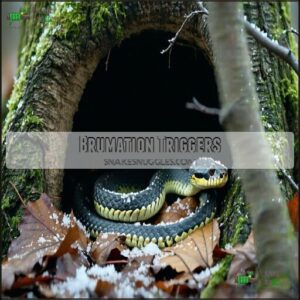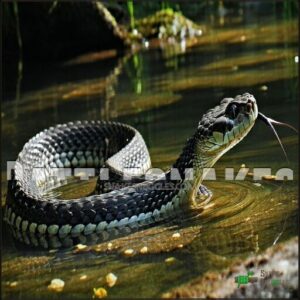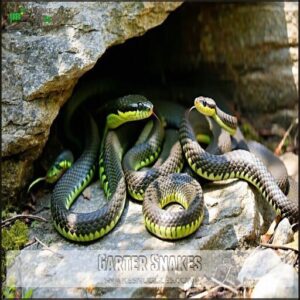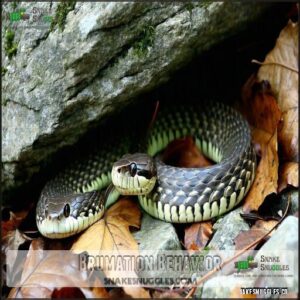This site is supported by our readers. We may earn a commission, at no cost to you, if you purchase through links.
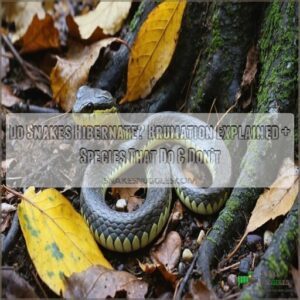 Snakes don’t hibernate like bears do, but they’ve got their own winter strategy called brumation. It’s like a cold-weather survival mode where their metabolism hits the brakes, letting them conserve energy when food’s scarce and temperatures drop.
Snakes don’t hibernate like bears do, but they’ve got their own winter strategy called brumation. It’s like a cold-weather survival mode where their metabolism hits the brakes, letting them conserve energy when food’s scarce and temperatures drop.
During brumation, snakes won’t eat, and they’re far less active, often hanging out in sheltered spots like burrows or under rocks to stay safe and cozy.
Not all snakes brumate, though—tropical species skip it altogether since their environment stays warm year-round.
Curious about which snakes brumate and how they pull it off? Stick around; there’s plenty more to uncover about these sneaky survivors.
Table Of Contents
- Key Takeaways
- Do Snakes Hibernate?
- What is Brumation?
- Brumation Triggers
- Species That Brumate
- Brumation Behavior
- Non-Brumating Species
- Frequently Asked Questions (FAQs)
- What is snake hibernation?
- How do snakes behave when they come out of hibernation?
- Do snakes hibernate in winter?
- How does climate affect snake hibernation?
- What Should I Do if I Encounter a Snake in Brumation?
- How Does a Snake Prepare for Brumation?
- Are There Any Signs of Snakes in an Area That I Can Look Out For?
- Can Snakes Brumate in Urban Areas?
- Where do snakes go during the winter?
- Can snakes bite in winter?
- Conclusion
Key Takeaways
- Snakes don’t hibernate like mammals; instead, they enter brumation, a lighter dormancy where their metabolism slows, conserving energy during colder months.
- During brumation, snakes stay semi-alert, waking occasionally to drink or bask, but avoid moving too much to preserve energy.
- Many species like rattlesnakes and garter snakes brumate, but tropical snakes and aquatic species often skip it due to consistent warm climates.
- Snakes prepare for brumation by eating more for fat storage, finding safe shelters like burrows or logs, and reducing activity as temperatures drop.
Do Snakes Hibernate?

Snakes don’t actually “hibernate” like mammals.
Instead, they experience brumation, a unique form of winter dormancy.
During brumation, their metabolism slows, helping them conserve energy while resting in hibernacula like burrows or tree stumps.
Unlike hibernating animals, brumating snakes may wake up on warmer days to drink water.
They also undergo significant physiological changes to conserve energy.
So, while it’s not true hibernation, snake brumation guarantees survival through reduced activity and clever adaptation to environmental changes.
What is Brumation?
When winter’s chill arrives, snakes use brumation—a lighter form of hibernation—to survive. This unique reptile dormancy slows their metabolism, allowing for energy conservation without the need for deep sleep seen in mammals. Think of it as their “power-saving mode.”
Unlike true snake hibernation, brumating snakes might wake up to drink water or relocate. They prepare for this winter dormancy by feeding and basking to build fat reserves. Their bodies adapt remarkably, staying functional with minimal activity.
Snakes rely on this behavior to endure harsh weather and limited food. However, brumation has challenges, like dehydration or disturbances.
- Metabolism slowdown: Conserves energy for months.
- Activity drop: Movement is rare.
- Sheltered spots: Found in burrows or under debris.
- Hormonal influence: Thyroid activity diminishes, aiding survival.
Brumation Triggers
Brumation kicks in when environmental cues, like dropping temperatures and shorter daylight hours, signal that it’s time.
These triggers help snakes conserve energy and survive harsh conditions until warmth returns, which is a crucial aspect of brumation.
Temperature Changes
A cold-blooded reptile’s survival hinges on sensing climate changes, especially dropping temperatures. For these ectothermic animals, cold signals reduced activity levels and a shift into brumation mode.
Temperature thresholds, often below 60°F, drive this process. Snakes often become inactive, as their metabolic rates slow in colder temperatures.
- Frost reaching hibernacula triggers dormancy.
- Persistent cool nights lower internal snake temperature.
- Long-term climate impact disrupts normal behavior.
- Regional variations affect brumation onset and duration.
- Ideal hibernacula temperature stays steady (around 2–12°C).
Understanding snake temperature responses helps guarantee better care during winter’s icy grip, which is crucial for their survival and well-being in cold temperatures.
Daylight Hours
When daylight decreases due to seasonal shifts, snakes sense nature’s Photoperiod Influence, which regulates their activity windows.
This shift, combined with temperature drops, triggers their instinct for overwintering through brumation. Shorter days send signals through their circadian rhythms, effectively adjusting their brumation length depending on latitude.
Here’s a quick breakdown:
| Factor | Impact | Snake Behavior |
|---|---|---|
| Photoperiod Influence | Shorter days | Triggers brumation instincts |
| Seasonal Shifts | Temperature drops | Prepares energy conservation |
| Latitude Impact | Varied winters | Adjusts dormancy duration |
| Activity Windows | Reduced mobility | Minimal movement to conserve energy |
| Overwintering Snakes | Shelter seeking | Safety from harsh conditions |
It’s like Mother Nature flipping the “winter mode” switch!
Species That Brumate
You’ll find that many snakes, like rattlesnakes and garter snakes, enter brumation to survive colder months.
Even pythons, despite their tropical origins, may show similar dormant behavior when temperatures drop.
Rattlesnakes
When temperatures drop, rattlesnakes enter brumation—a lighter version of snake hibernation.
They stay in hibernacula, typically rocky dens shared with other species like black rat snakes, benefiting from Den Sharing for warmth.
Metabolism slows, with fat reserves sustaining energy needs until spring.
Despite their dormancy, Venom Effects remain potent, ensuring survival when hunting resumes.
Regional Differences affect brumation timing, with rattlesnakes adapting based on local climates.
Rattlesnake Brumation showcases their incredible ability to navigate hostile winter environments.
Garter Snakes
Ever wondered how garter snakes handle winter? These clever, adaptable snake species don’t hibernate but brumate—a lighter dormancy.
Social brumation is common, with snakes gathering in rock piles, burrows, or even basements, sharing warmth for survival. Regional variations mean northern garter snakes may brumate for months, while southern ones enter shorter dormancy.
Beforehand, they stop eating to prevent digestive issues. In captive brumation, replicating their natural cool, humid surroundings safely taps into their instincts.
Spring wakeup? Time for basking, feeding, and busy mating habits again! Some garter snake species, like the checkered garter snake, are even listed as threatened due to habitat loss.
Pythons
Your tropical ball python won’t experience true brumation. Unlike species in colder climates, their evolution in Africa’s warm, stable environment means they’ve never needed to adapt to prolonged cold.
Mimicking winter conditions in captivity? That’s a recipe for disaster. These snakes require steady warmth year-round to maintain normal behavior and health.
Here’s what to know about caring for pythons:
- Python Habitats: Keep enclosures between 80-85°F, with a basking spot at 90-95°F.
- Python Care: Avoid temperature drops below 70°F, even at night.
- Python Behavior: Reduced appetite during cooler months doesn’t mean brumation.
- Python Diet: Skip feeding during colder periods; digestion requires warmth.
- Snake Hibernation: Pythons just aren’t built for reptile hibernation.
Optimal health relies on proper habitat products.
Brumation Behavior
When snakes enter brumation, they slow their metabolism, conserve energy, and minimize activity during colder months.
They also seek out sheltered spots like burrows or rock crevices to stay safe and regulate their body temperature.
Metabolism Slowdown
Brumation slows a snake’s metabolism, ensuring survival through winter.
Think of it as their “power-saving mode.”
Their body adapts by:
- Dropping heart rate to just a few beats per minute for energy conservation.
- Using glycogen stores for months without eating.
- Reducing respiration and kidney function to limit water loss.
- Allowing hormonal shifts, keeping them dormant and efficient, much like reptile hibernation superpowers.
Reduced Activity
During brumation, snakes master the art of minimal movement, slipping into a dormant state that’s all about energy conservation.
Their metabolic rate takes a nosedive, guaranteeing they burn as little fuel as possible.
Unlike true snake hibernation, brumation keeps them semi-alert—sort of like napping with one eye open.
Occasionally, they may indulge in basking behavior on warmer winter days, soaking up heat before retreating.
Proper insulation helps maintain consistent enclosure temperatures during this period.
This clever metabolic depression guarantees survival, even when resources like food are scarce.
Shelter Seeking
When winter hits, snakes rely on carefully chosen hibernation locations, or hibernacula, to survive harsh conditions.
Snakes seek cozy hibernacula to endure winter’s bite, finding safety in burrows, crevices, or hidden nooks for survival.
These spots include abandoned burrows, rock crevices, and even urban shelters like basements or garages. Some species, like rattlesnakes, embrace den sharing, gathering with hundreds of others for warmth.
Snakes seek ideal conditions, avoiding flooding, extreme cold, or stale air. A well-chosen hibernaculum offers protection and stability, allowing them to stay safe until spring.
Certain snakes, such as Northern Pine Snakes, even dig self-dug burrows. During this period, their metabolic rate slows to conserve energy.
Whether using natural shelters or human-made spaces, these dens play a critical role in ensuring a snake’s survival during brumation.
Non-Brumating Species
Not all snakes need to brumate, especially those in tropical or aquatic environments where temperatures stay warm year-round.
If you’ve ever wondered why some snakes seem active while others slow down, it’s all about how their habitats influence their behavior.
Tropical Snakes
You won’t catch tropical snakes brumating.
Living near the equator, these ectothermic reptiles thrive in consistent warmth.
Their equatorial activity aligns with steady habitat variation, while dietary needs shift to match local prey availability.
Breeding cycles? Flexible, adapting to food abundance.
In captivity, mimic their natural environment for best results.
Their conservation status, however, demands attention as habitat loss threatens these remarkable coldblooded animals with steady habitat variation.
Aquatic Snakes
Unlike most snakes, certain aquatic species skip brumation and keep active year-round.
Their unique physiology helps them adapt to changing water temperatures, ensuring they’re always on the move, even when most terrestrial snakes retreat into dormancy. By traversing freshwater habitats, these agile hunters stay hydrated, regulate body heat, and seize prey.
Here’s what sets non-brumating aquatic snakes apart:
- Water Temperature Adaptation: They adjust behavior with seasonal temperature shifts.
- Snake Hydration: Aquatic species thrive using humidity and water sources.
- Underwater Hibernacula Expertise: Freshwater ecosystems offer them dynamic shelters without compromising activity.
These non-brumating snakes prove winter doesn’t always demand dormancy.
Frequently Asked Questions (FAQs)
What is snake hibernation?
Imagine spotting a snake curled up in a basement pipe—it’s likely brumating, not hibernating.
Snakes enter this semi-dormant state, slowing their metabolism to survive cold months, occasionally waking to drink or bask.
How do snakes behave when they come out of hibernation?
When snakes emerge from hibernation, they gradually increase activity, bask in the sun to warm up, and search for water.
They don’t eat immediately, letting their metabolism catch up after months of dormancy.
Do snakes hibernate in winter?
When winter whispers its frosty lullaby, snakes don’t truly hibernate like bears.
Instead, they enter brumation—an energy-saving downtime where they stay sluggish but semi-alert, occasionally stirring for water or warmth in cozy hideaways, which is a state of being in a dormant-like condition, but not truly hibernate.
How does climate affect snake hibernation?
Climate plays a big role in snake brumation.
In colder areas, snakes brumate longer to survive harsh winters, while in warmer regions, they might stay active year-round.
Sudden warm spells can disrupt their brumation cycle entirely.
What Should I Do if I Encounter a Snake in Brumation?
If you find a brumating snake, don’t poke or move it.
Let it stay undisturbed, as waking it can harm its energy reserves.
Double-check your space to prevent accidental encounters, and stay calm!
How Does a Snake Prepare for Brumation?
You might think they don’t plan ahead, but snakes instinctively eat more to store fat, find secure spots like burrows or logs.
They gradually reduce activity as temperatures drop, ensuring they’re ready for brumation.
Are There Any Signs of Snakes in an Area That I Can Look Out For?
Look for shed snake skins, winding tracks in dirt or sand, or small burrow entrances.
Spotting unusual movement in brush or seeing snakes basking in the sun are also signs they’re around.
Can Snakes Brumate in Urban Areas?
Imagine cities as concrete jungles; yes, snakes can brumate here.
They seek out basements, garages, or even forgotten pipes, using these sheltered spaces to survive winter’s chill while staying hidden from urban life’s busy bustle.
Where do snakes go during the winter?
Snakes spend winter in sheltered spots called hibernacula—burrows, caves, or under logs—where temperatures stay above freezing.
Sometimes they cozy up in basements or garages.
They’re just chilling, conserving energy until spring warmth returns.
Can snakes bite in winter?
Even in winter’s icy grip, snakes can still bite if disturbed, especially during brumation.
Their metabolism slows, but instincts don’t take a vacation—so handle any sleepy serpents with care and respect their space!
Conclusion
Snakes don’t hibernate like cuddly bears—sorry if you were picturing one in a winter sweater—but brumation is their smart workaround for surviving cold months.
By slowing their metabolism, finding hidden shelters, and chilling (literally), some species like rattlesnakes and garter snakes stay safe until temps warm up.
Not all snakes follow this routine, though—tropical snakes are sunbathers, not brumators.
So, the next time you ask, “Do snakes hibernate?” remember: it’s all about brumation, not hibernation!

